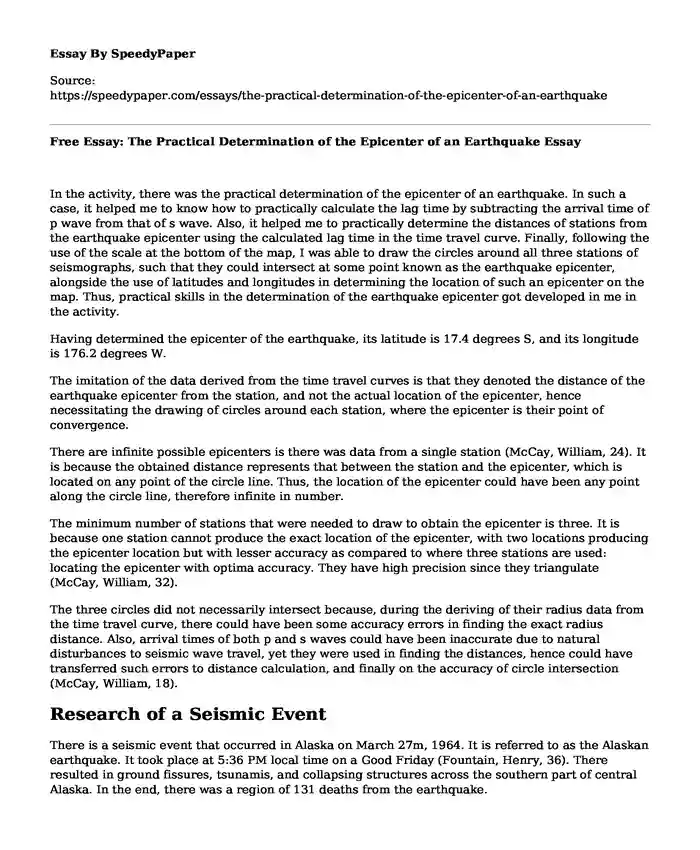In the activity, there was the practical determination of the epicenter of an earthquake. In such a case, it helped me to know how to practically calculate the lag time by subtracting the arrival time of p wave from that of s wave. Also, it helped me to practically determine the distances of stations from the earthquake epicenter using the calculated lag time in the time travel curve. Finally, following the use of the scale at the bottom of the map, I was able to draw the circles around all three stations of seismographs, such that they could intersect at some point known as the earthquake epicenter, alongside the use of latitudes and longitudes in determining the location of such an epicenter on the map. Thus, practical skills in the determination of the earthquake epicenter got developed in me in the activity.
Having determined the epicenter of the earthquake, its latitude is 17.4 degrees S, and its longitude is 176.2 degrees W.
The imitation of the data derived from the time travel curves is that they denoted the distance of the earthquake epicenter from the station, and not the actual location of the epicenter, hence necessitating the drawing of circles around each station, where the epicenter is their point of convergence.
There are infinite possible epicenters is there was data from a single station (McCay, William, 24). It is because the obtained distance represents that between the station and the epicenter, which is located on any point of the circle line. Thus, the location of the epicenter could have been any point along the circle line, therefore infinite in number.
The minimum number of stations that were needed to draw to obtain the epicenter is three. It is because one station cannot produce the exact location of the epicenter, with two locations producing the epicenter location but with lesser accuracy as compared to where three stations are used: locating the epicenter with optima accuracy. They have high precision since they triangulate (McCay, William, 32).
The three circles did not necessarily intersect because, during the deriving of their radius data from the time travel curve, there could have been some accuracy errors in finding the exact radius distance. Also, arrival times of both p and s waves could have been inaccurate due to natural disturbances to seismic wave travel, yet they were used in finding the distances, hence could have transferred such errors to distance calculation, and finally on the accuracy of circle intersection (McCay, William, 18).
Research of a Seismic Event
There is a seismic event that occurred in Alaska on March 27m, 1964. It is referred to as the Alaskan earthquake. It took place at 5:36 PM local time on a Good Friday (Fountain, Henry, 36). There resulted in ground fissures, tsunamis, and collapsing structures across the southern part of central Alaska. In the end, there was a region of 131 deaths from the earthquake.
The earthquake lasted for four minutes, and thirty-eight seconds, and had a magnitude of 9.2 MW (megathrust earthquake). It has remained the most powerful earthquake to be recorded on the American continent. There occurred a fault 970 kilometers long that raptured at once while moving up to the height of 18 meters (Fountain, Henry, 48). It released a stress build-up that lasted for 500 years. There were also geological impacts where landslides, soil liquefaction, and fissures occurred, alongside several other ground failures that resulted in significant damage to structures belonging to various communities living in the region. Also, their property got damaged in the process, where electricity posts were fell, houses damaged, and facilities such as schools were damaged.
Anchorage area managed to sustain immense destructions to buildings and infrastructure such as human-made equipment, water systems, sidewalks, and paved streets, more so in the land zones such as Knik Arm. Areas such as Kodiak which lie about 320 kilometers southwestwards got raised permanently to 30 feet high (Fountain, Henry, 14). Also, areas around Portage, Girdwood, and Turnagain Arm were dropped to a depth of 2.4 meters, hence requiring reconstruction alongside fill to get raised.
In total, the earthquake brought about economic damage of $311 million. There followed several aftershocks in the subsequent periods that followed the main earthquake. During the first day of the earthquake, eleven aftershocks were experienced with magnitudes higher than 6.0 MW (Fountain, Henry, 24). They were thousands of them, and they also further damaged some property that had been severely destroyed by the main earthquake.
Works Cited
Fountain, Henry. The Great Quake: How the Biggest Earthquake in North America Changed Our Understanding of the Planet. , 2017. Print.
McCay, William. After the Earthquake. Pelham, NY: Benchmark Education Co, 2011. Print.
Cite this page
Free Essay: The Practical Determination of the Epicenter of an Earthquake. (2023, Mar 12). Retrieved from https://speedypaper.com/essays/the-practical-determination-of-the-epicenter-of-an-earthquake
Request Removal
If you are the original author of this essay and no longer wish to have it published on the SpeedyPaper website, please click below to request its removal:
- Letter of Purpose, Free Example
- Arguments for God's Existence - Essay Sample in Philosophy of Religion
- Comparison Essay Sample: Baraka's Poetry Between the Beat and Islamic Phase
- Recommendations of nurses are that there should be an implementation of solutions by everyone present in the healthcare system because it is a collaborative issue. For an effective opioid analgesic presentation, there should be a primary prevention method. Considerations should be made when the physician is prescribing opioids to patients. Treatment of addicts should be made easier for patients, together with the needed resources, reachable assistant programs that should be an assurance policy changes that shall ease and avail programs that shall curb their addiction to opioid
- Essay Sample on Risk Management Strategies
- Organizational Systems and Quality Leadership - Free Essay
- Paper Example. Deterrence Theory in Criminology
Popular categories





